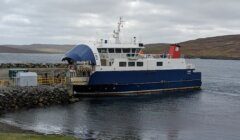Council / SIC needs to prioritise projects as not everything is achievable, finance boss warns
FINANCIAL forecasts suggest the council has made “limited progress” in addressing its long-term sustainability – but considerable challenges remain.
That is a key message from Shetland Islands Council’s (SIC) latest medium term financial plan, which forecasts how the local authority’s bank balance may look over the next six years.
The last plan, published in 2020, estimated a cumulative deficit of £103.6 million through to 2025/26 if no action was taken.
But the latest plan has a revised deficit of £76.8 million for the same period.
A recent entry into the council’s corporate risk register describes the current ‘risk rating’ of the ‘financially unsustainable position’ as “very high”.
A report due to be presented to councillors next week said this can be explained by “lower than anticipated net expenditure in 2020/21 and other positive changes, such as the Scottish Government providing additional funding to meet Covid-19 pressures and the full cost of inter-island ferry services”.
But there remains a “considerable challenge” in medium and long-term sustainability, the report warns, and this is beginning to impact how the council can finance its future capital plans.
On top of this, the council’s core funding from the Scottish Government for the next financial year is £590,000 less in cash terms than 2021/22, although local authorities will be able to raise council tax rates.
“The need to take action to address the council’s financial unsustainability is now becoming more pressing as the council seeks to proceed with a range of investments in services and infrastructure,” a report from finance manager Jamie Manson added.
Last year the council approved business cases which created an additional capital commitment of £35 million.
This is on top of the council’s current asset investment plan, which includes £120 million up to 2025/26.
Become a member of Shetland News
A large chunk of this is for a ferry and terminal replacement programme, while other planned spend includes a new Cullivoe road, the Knab site redevelopment and housing maintenance.
Further spend will also likely be needed in the years ahead to support programmes in climate change and the isles’ schools estate.
There is a statutory requirement to comply with a ‘prudential code’ when considering how much the council can borrow, though.
The SIC has “limited headroom” to increase its borrowing, the report warns, and using reserves as an alternative would result in lower returns on its investments in the years ahead.
The report concluded that the plan does not have the answers – that is down to the council developing strategies to address deficits.
“The council needs to acknowledge that it cannot achieve everything it would like to achieve with the resources it has available, and needs to prioritise which projects and programmes are taken forward in the future,” Manson warned.
Become a member of Shetland News
Shetland News is asking its readers to consider paying for membership to get additional perks:
- Removal of third-party ads;
- Bookmark posts to read later;
- Exclusive curated weekly newsletter;
- Hide membership messages;
- Comments open for discussion.
If you appreciate what we do and feel strongly about impartial local journalism, then please become a member of Shetland News by either making a single payment, or setting up a monthly, quarterly or yearly subscription.














































































